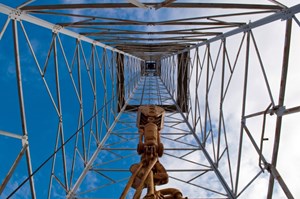Amid the understandable exuberance of North American land drilling contractors these days is an emerging trend that would have sounded preposterous a very short time ago: fewer rigs available to make hole.
Availability, however, is relative, as the perceived supply tightness pertains only to the rigs that discriminating shale operators are willing to put to work. Those include what is generally described as super-spec rigs, though the precise nomenclature of what constitutes said rigs varies from contractor-to-contractor. Regardless of what they’re called, operators eager to capture short-cycle returns, as oil and gas prices continue to hit multi-year highs, are demanding more and willing to pay for it.
“With the growth in activity across the industry, the market for Tier 1 drilling rigs is tight, and premium rigs are receiving a higher day rate,” says Andy Hendricks, CEO of Patterson-UTI Energy, Inc. “The market is much tighter than what is apparent by just looking at the market for super-spec rigs.”
While operators persist in proclaiming their commitment to capital discipline, they nonetheless are finding current commodity prices too attractive to ignore, adding 50 rigs between Feb. 4 and March 11. As of March 11, 663 rigs were active in the U.S., compared to 402 rigs the same time last year, according to Baker Hughes, and up by more than 171% from the record low of 244 active rigs in August 2020. The Canadian rig count stood at 206, compared to 116 active rigs on March 12, 2021.
“The super spec rig supply is tighter than most people understand, and customer demand will shortly absorb the remaining capacity,” says Kevin Neveu, CEO of Canada’s Precision Drilling Corp.
Partly driving the return to full-throttle drilling is a nearly 62% year-over-year drop in the inventory of drilled-but-uncompleted (DUC) wells. The latest data available from the seven US shale plays tracked by the US Energy Information Administration (EIA) documented a cumulative 4,372 DUC wells in February, down from 7,086 DUCs a year earlier.
Day rates, costs surge. After years of low-ball contract rates just to get a rig to work, day rates across the drilling sector are moving up rapidly. “The pricing environment is moving upward quickly. Our own leading-edge day rates now stand several thousand dollars higher than the daily average in the fourth quarter,” says Nabors Industries CEO and President Tony Petrello. “We see pricing accelerating, as industry utilization increases throughout the year.”
“In my 30 years at Nabors, it’s probably the hottest in terms of the ramp-up in day rates that it’s ever been. Of course, that’s off an extremely low point that was also unprecedented, so take it with a grain of salt,” he noted.
Patterson-UTI put 26 rigs to work in the U.S. between the third and final quarters of 2021, and depending on the technologies and ancillary equipment provided, some receive more than $30,000/day, up from a non-negotiable basic day rate. “For the base rig, we are now in the mid-$20,000s for day rates and that is where the discussions begin,” says Hendricks.
Precision follows a similar strategy. “The continuing pricing signal we send to our customers is our refusal to accept lower threshold day rates and walk away,” says Neveu.
The appreciably higher day rates also come in the face of four-decade-high inflation and stubborn supply chain issues, making everything from tubulars to labor appreciably more expensive and often unavailable. “We have seen higher costs across our supply chain. The primary stress factor in our supply chain remains vendor lead times, which have widened significantly,” says Petrello.
“Evolving preferences.” Hendricks said operators preferences for super-spec rigs are continually evolving, with more operators now requiring higher clearance beneath the rig floor, a third mud pump for additional horsepower and more redundancy. Optimally, the draw works should be installed 21 to 23 ft up on the rig floor, he said. “The extra room underneath the rig floor allows the rig to walk over wellheads and around existing production equipment on the pad,” he said. “The older-style rigs have limited clearance under the rig floor, because the drawworks are on the ground and are generally less desirable to operators.”
To put the market in perspective, Hendricks estimates 300 rigs in the U.S. land fleet can be upgraded to Tier 1 super-spec capability, but more than half are older-generation with the drawworks on the ground. “We believe the extensive upgrades these rigs will require to become Tier 1 rigs is economically prohibitive in the current market, and higher day rates will be needed to justify these upgrades,” he said.
Pass-through costs. John Lindsay, President and CEO of Helmerich & Payne Inc., said most of the super-spec rigs that meet operators’ requirements have been idled for more of the year, with re-activation costs of between $300,000–$500,000 passed along to the customer. “The tightening supply of readily available rigs, coupled with these cost increases, has already begun to move contract pricing effort in the market,” he said. “Based upon what we are experiencing today, we expect price increases will become even more pronounced in the coming months, as rig demand picks up into 2022.”
Given regional shortages, the Precision Drilling chief said operators also are paying the full trucking costs for basin-to-basin moves.
Higher operating costs notwithstanding, Hendricks believes the stars are hopefully aligned for long-awaited stability in contract drilling. “It’s been a long time since, as an industry, we have had the alignment of various economic factors that have the potential to lead to a multi-year scenario of stability,” he said.

- Coiled tubing drilling’s role in the energy transition (March 2024)
- Shale technology: Bayesian variable pressure decline-curve analysis for shale gas wells (March 2024)
- Digital tool kit enhances real-time decision-making to improve drilling efficiency and performance (February 2024)
- E&P outside the U.S. maintains a disciplined pace (February 2024)
- U.S. operators reduce activity as crude prices plunge (February 2024)
- Drilling advances (January 2024)



